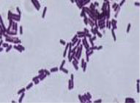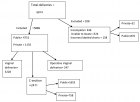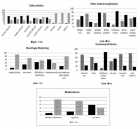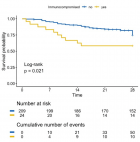Abstract
Research Article
Evaluation of the antibacterial and anticancer activities of marine Bacillus subtilis ESRAA3010 against different multidrug resistant Enterococci (MDRE) and cancer cell lines
Esraa Ahmed Mohamed* and Nourah Hassan Alzahran
Published: 28 October, 2020 | Volume 4 - Issue 1 | Pages: 018-027
Fifty nine isolates belonging to six species of Enterococci namely, Enterococcus faecalis, Enterococcus faecium, Enterococcus raffinosus, Enterococcus durans, Enterococcus mundtiiand Enterococcus avium (n = 35, 15, 4, 3, 1 and 1 isolates, respectively) were obtained from different clinical specimens including urine, pus, blood, wound, sputum and synovial fluid. The highest numbers of Enterococci were recorded from the pus (20 isolates, 33.90%) followed by urine (12 isolates, 20.34%) while the lowest frequency was observed with synovial fluid samples (2 isolates, 3.39%). These isolates showed different multidrug resistant patterns with the lowest resistant for linezolid (n = 5, 8.48%), followed by teicoplanin (n = 14, 23.73%) and vancomycin (n = 20, 33.90%) while they exhibited the highest resistant against penicillin (n = 53, 89.83%), oxacillin (n = 50, 84.75%), erythromycin (n = 49, 83.05%) and streptomycin (n = 47, 79.66 %). On the other hand, a free living marine bacterium under isolation code ESRAA3010 was isolated from seawater samples obtained from the fishing area Masturah, Red Sea, Jeddah, Saudi Arabia. The phenotypic, chemotaxonomic, 16S rRNA gene analyses and phylogenetic data proved that isolate ESRAA3010 is very close to Bacillus subtilis and then it was designated as Bacillus subtilis ESRAA3010. It gave the highest antagonistic activity against all clinical Enterococcus faecalis, Enterococcus faecium, Enterococcus raffinosus, Enterococcus durans, Enterococcus mundtiiand Enterococcus avium isolates under study with minimum inhibitory concentration (MIC) ranged from 4 to 56 µg/mL, 4 to 12 µg/mL, 4 to 8 µg/mL, 4 to 8 µg/mL, 8 µg/mL and 4 µg/mL, respectively as well as minimum bactericidal concentration (MBC) (8 to 64 µg/mL, 4 to 16 µg/mL, 4 to 12 µg/mL, 4 to 16 µg/mL, 12 µg/mL and 8 µg/mL, respectively). Moreover it showed anti-proliferative activity against colon (HCT-116), liver (HepG-2), breast (MCF-7) and lung (A-549) carcinomas with IC50 equal to 39, 50, 75 and 19 µg/mL, respectively which indicates its prospective usage in the upcoming decades.
Read Full Article HTML DOI: 10.29328/journal.abb.1001018 Cite this Article Read Full Article PDF
Keywords:
Multidrug resistant Enterococci; Marine Bacillus; Antibacterial; Anti-cancer; Molecular identification
References
- Asgin N, Otlu B. Antibiotic resistance and molecular epidemiology of vancomycin-resistant Enterococci in a tertiary care hospital in Turkey. Infect Drug Resist. 2020; 13: 191-198. PubMed: https://pubmed.ncbi.nlm.nih.gov/32021333/
- Jaiswal S, Singh A, Verma RK, Singh DP, Kumari S. Characterization, speciation and antimicrobial resistance pattern of Enterococcus species isolated from clinical specimens at a rural tertiary care hospital. Int J Res Med Sci. 2017; 5: 3484-3487.
- Faron ML, Ledeboer NA, Buchan BW. Resistance mechanisms, epidemiology and approaches to screening for vancomycin-resistant Enterococcus in the health care setting. J Clin Microbiol. 2016; 54: 2436-2447. PubMed: https://pubmed.ncbi.nlm.nih.gov/27147728/
- Karna A, Baral R, Khana B. Characterization of clinical isolates of Enterococci with special reference to glycopeptide susceptibility at a tertiary care center of Eastern Nepal. Int J Microbiol. 2019; 2019: 7936156.
- El-Gendy MMA, Mohamed ZK, Hekal NZ, Ali FM, Yousef AEM. Production of bioactive metabolites from different marine endophytic Streptomyces species and testing them against methicillin-resistant Staphylococcus aureus (MRSA) and cancer cell lines. BioTechnologia. 2018a; 99: 13-35.
- Nasaj M, Mousavi SM, Hosseini SM, Arabestani MR. Prevalence of virulence factors and vancomycin-resistant genes among Enterococcus faecalis and E. faecium isolated from clinical specimens. Iran J Public Health 2016; 45: 806-813. PubMed: https://pubmed.ncbi.nlm.nih.gov/27648425/
- Vo TTT, Lee CW, Wu CZ, Liu JF, Lin WN, et al. Surfactin from Bacillus subtilis attenuates ambient air particulate matter-promoted human oral cancer cells metastatic potential. J Cancer. 2020; 11: 6038-6049.
- Ki JS, Zhang W, Qia PY. Discovery of marine Bacillus species by 16S rRNA and rpoB comparisons and their usefulness for species identification. J Microbiol Methods. 2009; 77: 48-57. PubMed: https://pubmed.ncbi.nlm.nih.gov/19166882/ .
- Viju N, Punitha SMJ, Satheesh S. Antibiofilm activity of symbiotic Bacillus species associated with marine gastropods. Ann Microbiol. 2020; 70: 11.
- El-Gendy MMA, Abdel-Wahhab KG, Mannaa FA, Farghaly AA, El- Bondkly AMA. Carcinogenic activities and sperm abnormalities of methicillin resistance Staphylococcus aureus and inhibition of their virulence potentials by ayamycin. Appl Biochem Biotechno. 2017; 183: 833-852. PubMed: https://pubmed.ncbi.nlm.nih.gov/28389766/
- Kizhakkekalam VK, Chakraborty K, Joy M. Oxygenated elansolid-type of polyketide spanned macrolides from a marine heterotrophic Bacillus as prospective antimicrobial agents against multidrug-resistant pathogens. Int J Antimicrob Agents. 2020; 55: 105892.
- Koim-Puchowska B, Kłosowski G, Mikulski D, Menka A. Evaluation of various methods of selection of B. subtilis strains capable of secreting surface-active compounds. PLoS One. 2019; 14: e0225108. PubMed: https://pubmed.ncbi.nlm.nih.gov/31715626/
- Lv J, Da R, Cheng Y, Tuo X, Wei J, et al. Mechanism of antibacterial activity of Bacillus amyloliquefaciens C-1 lipopeptide toward anaerobic Clostridium difficile. Biomed Res Int. 2020; 2020: 3104613. PubMed: https://pubmed.ncbi.nlm.nih.gov/32190658/
- Mondol MAM, Hee JS, Mohammad TI. Diversity of secondary metabolites from marine Bacillus species: chemistry and biological activity. Mar Drugs. 2013; 11: 2846-2872.
- Liu Y, Lai Q, Du J, et al. Genetic diversity and population structure of the Bacillus cereus group bacteria from diverse marine environments. Sci Rep. 2017; 7: 689.
- Zhao M, Liang G, Zhou Y, et al. Novel Bacillus strains from the human gut exert anticancer effects on a broad range of malignancy types. Invest New Drugs. 2020; 38: 1373-1382.
- Collins MD, Jones D, Farrow JAE, Kilpper-Balz R, Schleifer KH. Enterococcus avium nom. rev., comb. nov.; E. cusselifluvus nom. rev., comb. nov.; E. durans nom. rev., comb. nov.; E. gallinarum comb. nov.; and E. malodoratus sp. nov. Int J Syst Bacteriol 1984; 34: 220-223.
- Devriese LA, Van De Kerckhove A, Kilpper-Balz R, Schleifer KH. Characterization and identification of Enterococcus species isolated from the intestines of animals. Int J System Bacteriol. 1987; 1987: 257-259.
- Facklam RR, Collins MD. Identification of Enterococcus species isolated from human infections by a conventional test scheme. J Clin Microbiol. 1989; 27: 731-734. PubMed: https://pubmed.ncbi.nlm.nih.gov/2656745/
- Haritsa KB, Shashikala N, Kumar SDC, Sampath S. Isolation, identification and speciation of Enterococci and their antimicrobial susceptibility in a tertiary care hospital. J Evol Med Dent Sci 2014; 3: 13893-13899.
- Manero A, Blanch AR. Identification of Enterococcus Spp. with a biochemical key. Appl Environ Microbiol. 1999; 65: 4425-4430.
- Winn WC. Koneman’s color atlas and textbook of diagnostic microbiology. Lippincott Williams & Wilkins. 2006; Philadelphia, PA, USA.
- Yilema A, Moges F, Tadele S, Endris M, Kassu A, et al. Isolation of Enterococci, their antimicrobial susceptibility patterns and associated factors among patients attending at the university of Gondar Teaching Hospital. BMC Infect Dis. 2017; 17: 276. PubMed: https://pubmed.ncbi.nlm.nih.gov/28412932/
- World Health Organization Expert Committee on biological standardization. Technical report series. 1992; 822. WHO, Geneva.
- CLSI: Clinical and Laboratory Standards Institute. Approved standard M2-A10. Performance standards for antimicrobial susceptibility tests. 2010a; 10th ed. CLSI, Wayne, Pa.
- CLSI: Clinical and Laboratory Standards Institute. CLSI document M100-S19. Performance standards for antimicrobial susceptibility testing. 2010b; 20th informational supplement, Wayne, Pa.
- EUCAST: European Committee on Antimicrobial Susceptibility Testing. EUCAST QC Tables V1.2. 2010.
- Ivanova EP, Mikhailov VV, Andreev LA. Marine bacilli and some approaches to their identification. Mikrobiol Zhurnal. 1992; 54: 27-33.
- Ivanova EP, Nicolau DV, Yumoto N, Taguchi T, Okamoto K, et aL. Impact of the conditions of cultivation and adsorption on antimicrobial activity of marine bacteria. Mar Biol. 1998; 130: 545-551.
- Donnel AGO, Norris JR, Berkeley RCW, Claus D, Kanek T, et al. Characterization of Bacillus subtilis, Bacillus pumilus, Bacillus licheniformis, and Bacillus amyloliquefaciens by pyrolysis gas-liquid chromatography, deoxyribonucleic acid-deoxyribonucleic acid hybridization, biochemical tests, and API systems. Int J System Bacteriol. 1980; 30: 448-459.
- Farrow JAE, Wallbanks S, Collins MD. Phylogenetic interrelationship of round-spore-forming bacilli containing cell walls based on lysine and the non-spore-forming genera Caryophanon, Exiguobacterium, Kurthia, and Planococcus. Int J Syst Bacteriol. 1994; 44: 74-82. PubMed: https://pubmed.ncbi.nlm.nih.gov/8123563/
- Logan NA, Berkeley RCW. Identification of Bacillus strains using the API system. J Gen Microbiol. 1984; 130: 1871-1882. PubMed: https://pubmed.ncbi.nlm.nih.gov/6432953/
- El-Bondkly AM, El-Gendy MMAA, Wiese J, Imhoff JF. Phylogenetic diversity and antimicrobial activities of culturable endophytic actinobacteria isolated from different Egyptian marine sponges and soft corals. Australian Journal of Basic and Applied Sciences. 2012a; 6(4): 25-33.
- El-Bondkly AMA, El-Gendy MMAA, Bassyouni RH. Overproduction and biological activity of prodigiosin-like pigments from recombinant fusant of endophytic marine Streptomyces species. Antonie Van Leeuwenhoek. 2012b; 102: 719-734. PubMed: https://pubmed.ncbi.nlm.nih.gov/22777253/
- El-Gendy MMAA, El-Bondkly AMA. Evaluation and enhancement of heavy metals bioremediation in aqueous solutions by Nocardiopsis sp. MORSY1948, and Nocardia sp. MORSY2014. Brazilian Journal of Microbiology. 2016; 47: 571-586.
- Saitou N, Nei M. The neighbor-joining method: a new method for reconstructing phylogenetic trees. Molecular Biology and Evolution. 1987; 4(4): 406-425.
- Tamura K, Nei M, Kumar S. Prospects for inferring very large phylogenies by using the neighbor-joining method. Proc Natl Acad Sci U S A. 2004; 101: 11030-11035. PubMed: https://pubmed.ncbi.nlm.nih.gov/15258291/
- Kumar S, Stecher G, Li M, Knyaz C, Tamura K. MEGA X: Molecular evolutionary genetics analysis across computing platforms. Mol Biol Evol. 2018; 35: 1547-1549. PubMed: https://pubmed.ncbi.nlm.nih.gov/29722887/
- Cappuccino JG, Sherman N. Microbiology: A Laboratory manual. 4th Ed., Addison Wesley Longman, Inc. Harlow, England 1999; 199-204.
- Lavermicocca P, Valerio F, Visconti A. Antifungal activity of phenyl lactic acid against molds isolated from bakery products. Appl Environ Microbiol. 2003; 69: 634-640. PubMed: https://pubmed.ncbi.nlm.nih.gov/12514051/
- Mosmann T. Rapid colorimetric assays for cellular growth and survival: Application to proliferation and cytotoxicity assay. J Immunol Methods. 1983; 65: 55-63. PubMed: https://pubmed.ncbi.nlm.nih.gov/6606682/
- Wilson AP. Cytotoxicity and viability assays in animal cell culture: A Practical Approach. 3rd ed. (ed. Masters JRW) 2000; Oxford University Press.
- Ahmad J, Kakru D, Bali N, Lone S, Bashir H, Fomda B. Prevalence and risk factors for vancomycin resistant Enterococci isolated from clinical samples in Kashmir, North India: A hospital based study. J Adv Med Res. 2015; 12: 01-07.
- Tripathi A, Shukla SK, Singh A, Prasad KN. Prevalence, outcome and risk factor associated with vancomycin-resistant Enterococcus faecalis and Enterococcus faecium at a tertiary care hospital in Northern India. Indian J Med Microbiol. 2016; 34: 38-45. PubMed: https://pubmed.ncbi.nlm.nih.gov/26776117/
- Yadegarynia D, Roodsari SR, Arab-Mazar Z. Evaluation of antimicrobial susceptibility among Enterococcus species by E-test method at Khatamol Anbia hospital during 2013-2014. Archives of Clinical Infectious Diseases. 2016; 11: e60124.
- El-Gendy MMAA, El-Bondkly AMA, Keera AA, Ali AM. Incidence of methicillin-resistant Staphylococcus aureus (MRSA) in microbial community of cancer patients and evaluation of their resistant pattern. Arabian J Sci Engineering. 2018b; 43: 83-92.
- Sood S, Malhotra M, Das BK, Kapil A. Enterococcalinfections & antimicrobial resistance. Indian J Med Res. 2008; 128: 111-121. PubMed: https://pubmed.ncbi.nlm.nih.gov/19001673/
- Valentina Y, Umadevi S, Pramodhini S. Comparison of different phenotypic methods for detection of vancomycin resistant Enterococci (VRE) among clinical isolates. IP Int J Med Microbiol Trop Dis. 2020; 6: 123-125.
- Varghese V, Menon AR, Nair KP. Speciation and susceptibility pattern of Enterococcalspecies with special reference to high level gentamicin and vancomycin. J Clinic Diagn Res. 2020; 14: DC08- DC12.
- Freitas-Silva J, Silva-Oliveira T, Muricy G, Laport MS. Bacillus strains associated to Homoscleromorpha sponges are highly active against multidrug resistant bacteria. Curr Microbiol. 2020; 77: 807-815. PubMed: https://pubmed.ncbi.nlm.nih.gov/31925513/
Figures:

Figure 1

Figure 2

Figure 3

Figure 4

Figure 5
Similar Articles
-
Overview of Interferon: Characteristics, signaling and anti-cancer effectKangjian Zhang*,Huaiyuan Wang,Haijun Hu. Overview of Interferon: Characteristics, signaling and anti-cancer effect. . 2017 doi: 10.29328/journal.hjb.1001001; 1: 001-016
-
Evaluation of the antibacterial and anticancer activities of marine Bacillus subtilis ESRAA3010 against different multidrug resistant Enterococci (MDRE) and cancer cell linesEsraa Ahmed Mohamed*,Nourah Hassan Alzahran. Evaluation of the antibacterial and anticancer activities of marine Bacillus subtilis ESRAA3010 against different multidrug resistant Enterococci (MDRE) and cancer cell lines. . 2020 doi: 10.29328/journal.abb.1001018; 4: 018-027
-
Utilization of Molecular Simulation Applications for Stability Testing of Anthocyanin Compounds in Black ElderberryRichard Benedict*. Utilization of Molecular Simulation Applications for Stability Testing of Anthocyanin Compounds in Black Elderberry. . 2023 doi: 10.29328/journal.abb.1001035; 7: 012-017
-
Microalgal Derivatives as Potential Nutraceutical and Pharmaceutical: Boon to Human BeingsNamrata Dash, Amit Kumar Bajhaiya, Chandrashaker B, Poornachandar Gugulothu*. Microalgal Derivatives as Potential Nutraceutical and Pharmaceutical: Boon to Human Beings. . 2024 doi: 10.29328/journal.abb.1001040; 8: 0170-026
-
Antibacterial Resistance and Extended-Spectrum Beta-Lactamase (ESBL) Phenotypes in Enterobacteriaceae Isolated from Fecal Samples of Humans and Animals in Selected Local Government Areas of Nasarawa State, NigeriaRICHARD R*, EZEJIOFOR T.I.N, NSOFOR C.A, MANINGI N.E. Antibacterial Resistance and Extended-Spectrum Beta-Lactamase (ESBL) Phenotypes in Enterobacteriaceae Isolated from Fecal Samples of Humans and Animals in Selected Local Government Areas of Nasarawa State, Nigeria. . 2024 doi: 10.29328/journal.abb.1001041; 8: 027-033
Recently Viewed
-
Leiomyosarcoma in pregnancy: Incidental finding during routine caesarean sectionToon Wen Tang*,Phoon Wai Leng Jessie. Leiomyosarcoma in pregnancy: Incidental finding during routine caesarean section. Clin J Obstet Gynecol. 2021: doi: 10.29328/journal.cjog.1001094; 4: 092-095
-
Adult Neurogenesis: A Review of Current Perspectives and Implications for Neuroscience ResearchAlex, Gideon S*,Olanrewaju Oluwaseun Oke,Joy Wilberforce Ekokojde,Tolulope Judah Gbayisomore,Martina C. Anene-Ogbe,Farounbi Glory,Joshua Ayodele Yusuf. Adult Neurogenesis: A Review of Current Perspectives and Implications for Neuroscience Research. J Neurosci Neurol Disord. 2024: doi: 10.29328/journal.jnnd.1001102; 8: 106-114
-
Late discover of a traumatic cardiac injury: Case reportBenlafqih C,Bouhdadi H*,Bakkali A,Rhissassi J,Sayah R,Laaroussi M. Late discover of a traumatic cardiac injury: Case report. J Cardiol Cardiovasc Med. 2019: doi: 10.29328/journal.jccm.1001048; 4: 100-102
-
A two-phase sonographic study among women with infertility who first had normal sonographic findingsKalu Ochie*,Abraham John C. A two-phase sonographic study among women with infertility who first had normal sonographic findings. Clin J Obstet Gynecol. 2022: doi: 10.29328/journal.cjog.1001117; 5: 101-103
-
Sinonasal Myxoma Extending into the Orbit in a 4-Year Old: A Case PresentationJulian A Purrinos*, Ramzi Younis. Sinonasal Myxoma Extending into the Orbit in a 4-Year Old: A Case Presentation. Arch Case Rep. 2024: doi: 10.29328/journal.acr.1001099; 8: 075-077
Most Viewed
-
Evaluation of Biostimulants Based on Recovered Protein Hydrolysates from Animal By-products as Plant Growth EnhancersH Pérez-Aguilar*, M Lacruz-Asaro, F Arán-Ais. Evaluation of Biostimulants Based on Recovered Protein Hydrolysates from Animal By-products as Plant Growth Enhancers. J Plant Sci Phytopathol. 2023 doi: 10.29328/journal.jpsp.1001104; 7: 042-047
-
Sinonasal Myxoma Extending into the Orbit in a 4-Year Old: A Case PresentationJulian A Purrinos*, Ramzi Younis. Sinonasal Myxoma Extending into the Orbit in a 4-Year Old: A Case Presentation. Arch Case Rep. 2024 doi: 10.29328/journal.acr.1001099; 8: 075-077
-
Feasibility study of magnetic sensing for detecting single-neuron action potentialsDenis Tonini,Kai Wu,Renata Saha,Jian-Ping Wang*. Feasibility study of magnetic sensing for detecting single-neuron action potentials. Ann Biomed Sci Eng. 2022 doi: 10.29328/journal.abse.1001018; 6: 019-029
-
Pediatric Dysgerminoma: Unveiling a Rare Ovarian TumorFaten Limaiem*, Khalil Saffar, Ahmed Halouani. Pediatric Dysgerminoma: Unveiling a Rare Ovarian Tumor. Arch Case Rep. 2024 doi: 10.29328/journal.acr.1001087; 8: 010-013
-
Physical activity can change the physiological and psychological circumstances during COVID-19 pandemic: A narrative reviewKhashayar Maroufi*. Physical activity can change the physiological and psychological circumstances during COVID-19 pandemic: A narrative review. J Sports Med Ther. 2021 doi: 10.29328/journal.jsmt.1001051; 6: 001-007

HSPI: We're glad you're here. Please click "create a new Query" if you are a new visitor to our website and need further information from us.
If you are already a member of our network and need to keep track of any developments regarding a question you have already submitted, click "take me to my Query."


















































































































































